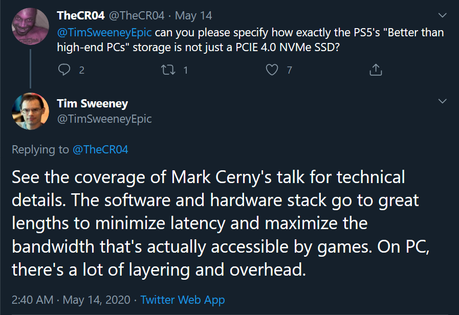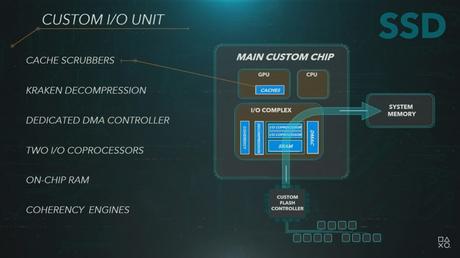Both Sony and Microsoft will launch their latest game consoles this year. Among other things, one of the talking point for many, has been the PlayStation 5 SSD.
In the meanwhile, if you can’t wait for the next gen game consoles and have nothing but a PC/Laptop without dedicated graphics, you can still play games! Head over to my answer to : What Are the Best Games for PC Without Graphics Card?
Almost 10 years after SSD’s became pretty common in gaming PCs, the consoles have finally caught up. Both Microsoft and Sony will start shipping their next gen consoles with SSDs instead of hard disks for the first time in 2020.
What’s interesting though, is that the bold claims by Tim Sweeney about PlayStation 5 SSD being ‘way ahead’ of any SSD you can put in a PC might actually be true. You might think, with RAID0 and PCIe Gen 4 NVME SSDs, you can reach up to 30 GB/s throughput (Even more with Optane, by the way). So how can a single PlayStation 5 SSD be better than any such configuration? The answer to that, is pretty interesting. But first, let’s get to know what all this fuss is about.
PlayStation 5 SSD: What Tim Sweeney Actually Said
The Epic Games founder and CEO displayed a lot of affection for the PlayStation 5 SSD and the performance difference it would make going forward for games.
In his exact words, he said “Sony’s storage architecture is far ahead of the best SSD solution you can buy on PC today. And so it’s really exciting to be seeing the console market push forward the high-end PC market in this way”.
Apart from the high praise here, there are a few things to take note of. Nowhere has been mentioned the RAW performance of the SSD itself, but the storage solution altogether has been the talking point in his tweets.
He also referenced the Mark Cerny’s conference that shed light on how the hardware and software of the PlayStation 5 would be better with respect to everything else available to consoles. He said, “See the coverage of Mark Cerny’s talk for technical details. The software and hardware stack go to great lengths to minimize latency and maximize the bandwidth that’s actually accessible by games. On PC, there’s a lot of layering and overhead.”

With that cleared out, let us understand where the PlayStation 5 SSD has advantages over any SSDs used in a PC.
PlayStation 5 SSD vs Any SSD in a PC
As PS5 lead system architect Mark Cerny showcased in the ‘Road to the PS 5′ demonstration, the PlayStation 5 has a custom made SSD at its disposal. Not only it’s way faster than the hard disk that older PlayStations shipped with, the entire storage system has been revamped.
Sony custom designed the PlayStation 5 SSD particularly for its own purpose. The storage size on the PlayStation 5 SSD is confirmed to be of 825 GB. Now Let’s understand how it works.
I looked into the details of the engineering behind this fully Custom I/O Unit of the PlayStation 5, and I have tried putting into simpler words for everyone to understand.
How the PlayStation 5 SSD and the I/O Unit Works

- One of the I/O Co-Processors handles the SSD I/O. This means that the PlayStation 5 can perform significantly better random read/write operations, because it does not have the overheads of the traditional File I/O System.
- The coherency engine, helps the two I/O Co-Processors in deciding which cache to flush. So, instead of flushing the whole cache when programs are moved to the background, the coherency engine will be helpful in flushing only the coherent (or related) data from the cache.
- Cache Scrubbers, inside the GPU module, are alerted by the coherency engine about which parts of the cache have been overwritten.
- The other I/O Co-Processor, along with a dedicated DMA controller, handles DMA and memory mapping.
- The biggest player here, is the Kraken decompression. Having physical de-compressors for data in compressed Kraken format allows the PlayStation 5 SSD to ‘streamline’ graphics based on the player’s interaction with the gaming engine.
- The custom flash controller built into the SSD allows Sony to manage data in their own methods, rather than using just any other NVME SSD with a general controller.
What’s the most fascinating part you might ask? The game developers do not have to worry about any of this stuff!
How Any SSD in a PC Works While Gaming
You can put any SSD with mind-blowing specs inside a fully maxed out gaming battle-station, with PCIe Gen 4 lanes at its disposal but the way games are rendered on Windows is the real bottleneck here. For any graphic to load inside a game, the following procedure is executed:
- Game Code requests data from Kernel.
- Kernel checks permissions and requests data from the SSD.
- SSD acknowledges, kernel sends a data copy to RAM.
- Game Code requests RAM Space to place uncompressed data.
- Kernel allocates space (Swap occurs if required).
- CPU Starts Decompression, Game Code saves uncompressed data onto the allocated space, requests Driver Code to copy it into GPU.
- Driver Code requests kernel-side driver code to share data with the GPU.
- Kernel-side driver code then tells GPU to copy the data into it’s VRAM.
- GPU Acknowledges, copies data, reverts back to kernel-side driver code.
- The acknowledgement is passed right back to the Game Code, and Game Code tells GPU to start rendering.
- Driver Code informs the GPU how the data should be used, and kernel side-driver code tells GPU how data inside the GPU VRAM should be used.
It is unclear how the pipeline for the PlayStation 5 would be. But from what I can tell by looking at the obstacles that a PC game render would have to overcome, PlayStation 5 can have a lot smoother graphics pipeline.
Conclusion
The work put into the PlayStation 5 by Sony’s engineers will definitely lead to a better gaming experience for everyone.
You can hate console makers for providing us with consoles that can be outperformed by PCs at the same price all you want. But the way AMD, Sony and Microsoft together shape the industry’s future is represented every time by a new fresh console release.
I started writing about the PlayStation 5, especially the PlayStation 5 SSD, just to clarify if it was actually ‘way ahead’ of any SSDs available to PCs. I was fascinated by to what depths I could go inside Sony’s engineering research and development for the PlayStation 5.
I wish to write on the PlayStation 5, and about the XBox Series X consoles pretty soon, so make sure you get the latest updates by subscribing to the newsletter!

